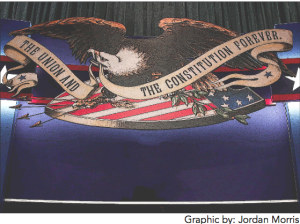Only 15 percent of eligible voters chose the next Commander-In-Chief
By: Andrew Ameer
Opinions Editor
In the past few weeks, we have seen the two major presidential candidates debate right here in St. Louis when Hillary Clinton and Donald Trump went head to head on the debate stage at Washington University.
The two candidates have the lowest approval ratings of any two major nominees in history, which is astounding, considering that during the primary process we had a variety of candidates who had huge levels of support.
But we can’t be surprised by our current choices when people don’t turn out to vote in primaries, which, if individual voters want a specific candidate, are probably even more important than the election itself.
In the 2016 primary, only 28.5 percent of eligible voters voted, according to the Pew Research Center.
This number is even less impressive when we compare the two parties- less than 15 percent of each major party’s eligible voting base actually voted in the primaries.
The Republican Party had a “record” turnout, with 14.8 percent of its eligible base turning out to vote in the primary, which was higher than in 2012 and 2008 (11 percent and 9.8 percent).
It was in fact the highest year yet for a GOP primary turnout.
The Democratic Party fared less well, with 14.5 percent turnout in the primaries, a far cry from the record 19.5 percent turnout in 2008.
It’s still the second best year on record for the Democrats, but that’s not good enough when a candidate is nominated who has the lowest approval rating in history for the party.
What all this means, effectively, is that only about 15 percent of the people in this country choose the next president of the United States.
Does this sound like the recipe for a strong democracy with happy people? I doubt it.
People complain endlessly about the way things are, but one of the easiest ways we have to address some of these problems is to turn out and vote, especially in the primaries and other smaller elections, state and local included.
Those 15 percent of people are likely to be extremely happy with whatever the result is in November — the rest of us, the other 85 percent, not so much.
This highlights why it is so important to pay attention to the primary process.
Usually only the real political buffs pay much attention to the primaries, but this needs to change.
Primaries are the season when candidates like Gary Johnson and Bernie Sanders, the ones with widespread popular support but perhaps not the support of the major media corporations can gain great ground.
If more people stood up and used their voice, which means actually volunteering, canvassing, and voting in the primaries, there would be less dissatisfaction with the candidates we eventually end up with.
We can’t leave any political office, much less the highest office in the land up to a handful of political junkies, which is essentially what happens when there is such a small turnout.
Too many voters remain undecided until too late in the game, then they are not satisfied with their choice, resorting to choosing the least bad of two very bad options.











